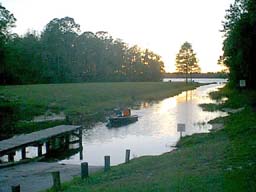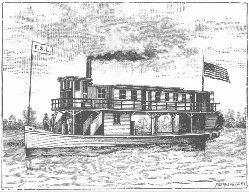| Lakes Alto and Santa Fe are connected by a man
made canal system, both lakes have good fishing, including bass, bream, and catfish. There
are two public ramps in the Waldo area: Waldo Canal Park located on the east side of Rt.
301 in Waldo, and County Park and ramp with very good parking off County Road 1471 about a
mile and a half east of Rt. 301. Shipman's Fishing Camp is located at Earleton Beach at
Earleton on Lake Santa Fe. Lakes Alto and Santa Fe are the highest locations in alachua
County. Lake Alto is approximately 4 miles long and Lake Sante Fe is
approximately 6 miles long. These Lakes are the headwaters of the Santa Fe River. Santa
Fe River, Santa Fe Lake and Santa Fe Swamp have been in the news at times during the
controversy over proposed peat mining in the the Swamp.
Water was the primary means of transportation in the Waldo area during the 1870's and
80's. when the South was recovering from the hardships of reconstruction after the Civil
War. There was limited access to railroads and a lack of good roads, leaving many areas
using rivers and streams to transport their lumber, citrus, cotton, and other products to
market.
The new town of Melrose, located at the south end of Lake Santa Fe, was in need of
better access to the Railroad The distance to Waldo and the closest railroad and depot was
nine miles. Roads were so poor that four hours were required to get there by horseback or
wagon.
The residents of the Waldo area were not content with the
inadequate transportation available, even with the advent of the Railroad. The Railroad
crossed Florida, which created a new need for transportation leading to the Railroad.
Bellamy Road from Waldo to Melrose part of which in the
Putnam County section, was called Banana, was deep sand. Lakes Alto and Santa Fe were
separated by a narrow point of land. Travel could be accomplished through the pass between
the two Lakes by boat. It was decided to dig a canal from the town of Waldo down to the
shores of Lake Alto. Then, from the other side of Lake Alto, another canal to Little Lake
Santa Fe, making transportation from Waldo to Melrose much easier and faster.
The Santa Fe Canal Company was chartered on March 2, 1877. The purpose of the Company
was to open steam boat navigation from Lake Geneva and Santa Fe Lake, through Lake Alto to
Waldo. A spur line at Waldo to Lake Alto was built from the Fernandina To Cedar Key
railroad for the Steamboat to load and unload produce from farms around the Lakes to send
to Northern markets.
Roads were not always passable and in very bad condition in the early days, making
water transportation important in Florida, during the Reconstruction Era after the Civil
War.
According to old issues of the Gainesville Weekly Bee, officers of the canal company
were
Officers -
George C. Bixford -
President
B.B. Ewing of Santa Fe Lake - Vice President
T.A. Peek of Waldo - Treasurer
Neel E. Farrell of Waldo - Chief Engineer
D.S. Place of Waldo - Secretary
Board of Directors -
General Ellias Earle of Earleton on Santa Fe Lake
Hiram Alderman of Geneva
W.X. Cessna of Gainesville
Money for construction of the Canal was raised by issuing 150 shares
of stock for $100 per share. The main office of the canal company was in Waldo, with
branch offices in Melrose, Banana and other pick-up points.
The route for the Canal was surveyed by Joseph Voyle in
May, 1877. A dredge was constructed in March and April of 1878. The dredge was designed by
Waldo resident Elgin, Ned Farrell, was engineer of the dredging boat. Captain Barker had
been in command of the dredge, with William Birt serving as Engineer. Almost two years
later it was announced that the wood-burning, steam powered dredge was ready to make its
final cut into Santa Fe Lake, completing the last leg of the Waldo-Melrose canal.
Excavation had started at the Waldo end, reaching Lake Sante Fe in May 1879.
The Weekly Bee of Gainesville reported that the
navigation company was owed a debt of gratitude for the "pluck, skill, and
perseverance" in sticking to and pushing this needed work to its present
successful condition in the face of ridicule and jeers that were inflicted upon them by
those who would benefit most from this important enterprise.
On March 9, 1881 a canal was completed between Lake Alto
and Lake Santa Fe making it possible for a steam boat to visit the farms around the lakes
to buy their produce. The produce was taken to a railroad spur in Waldo where it was
unloaded for the trip to northern markets. Oranges were one of the larger crops which were
sold for the northern markets until the Big Freeze in the 1890's which destroyed the
groves of citrus. Citrus was lost as a commercial crop, leaving the hauling of lumber,
shipping of flowering plants and pleasure cruises around the Lakes as the only sources
left for revenue to operate the Steamboat.

A Channel off Lake Alto
|

FS Lewis
|
The first steamboat on the canal after the dredging was the
F.S.Lewis, The dredge had been built by Waldo resident named Elgin. He also
designed the paddle wheeler for Lewis, Steger, and Farrell which was named for Lewis. The F.S.Lewis
made its maiden voyage April 26, 1881, carrying a happy group of people from Waldo on a
round trip to Melrose. It was between 65 and 70 feet long, had two decks and was of the
same design s the Mississippi River paddle wheelers. The canal was 30 feet wide and a
depth of five feet . When the water was low in the summer, or when soil washed down the
canal banks, traffic was blocked until it could be cleared. The F.S.Lewis was
built in Waldo. The Captain was S.C. Barker, who spent his younger years in command
of sea craft.
From the beginning the large unweildy F.S.Lewis had problems. On the first trip
the drive shaft to the paddle wheel broke. Mail could not be delivered to Earleton because
the boat drew too much water for the boat to come in close to shore. Another stroke of bad
luck , when in a strong wind the boat capsized. One day it burned in the Canal due to a
fire caused by the boiler. The old dredge sank while tied up at Shooter's Landing on Santa
Fe Lake.
Three years later, a devastating blow befell the steam boat, February 1884. As recorded
by Mrs. Tolles; "On the last Friday of the month, lake region residents awoke to the
headlines on the front page of the Florida Times-Union - STEAMER BURNED - special
dispatch…Waldo, March 1."
"The Steamer F.S.Lewis, which runs between this city and Melrose, was burned early
yesterday morning in the Santa Fe Canal. The fire originated in the boiler area. Loss
$6,000, no insurance.
The people of Melrose were very upset, with their freight transportation gone and no
apparent wat to acquire another boat, they faced a major financial setback. Fortunately
help came unexpectedly through the merger of some of the Northeast Florida Railroads into
one new company, THE FLORIDA RAILWAY AND Navagation company. One of their goals was to
replace the F.S.Lewis with a smaller vessel.
A tugboat was purchased in Jacksonville and transported by flat car to Waldo. There
would be no more moonlight excursions on such a small work-boat, but it carried freight
which had become so important to people in the Lake region. A boat used mainly for towing
was also purchased from Jacksonville. This one was between eighteen and twenty feet long
and had an upright boiler. These boats worked between Waldo and Melrose from the 1870's
until after the turn of the century.
 THE ALERT, was a sturdy tugboat, sixty feet long
and fourteen feet in the beam, it had a good engine and propeller. It was docked at Waldo.
It too, could not pick up mail at Earleton because the water was too shallow near the
shore. The Alert was one of the most popular boats, although it was smaller than the
F.S.Lewis, it could carry passengers and freight. In its issue of March 27, 1886, the
first Melrose newspaper, "MELROSE DAYLIGHT FLASHES', reported that quite a number of
people traveled on the Alert to see the Blanche Curtisse dramatic company in "Only a
Farmer's Daughter" at the Waldo Opera House. The boat returned at midnight. The
Alert also carried the American Flag with 13 stars and stripes. It operated until World
War I when the roads were improved and automobiles diminished its usefulness. THE ALERT, was a sturdy tugboat, sixty feet long
and fourteen feet in the beam, it had a good engine and propeller. It was docked at Waldo.
It too, could not pick up mail at Earleton because the water was too shallow near the
shore. The Alert was one of the most popular boats, although it was smaller than the
F.S.Lewis, it could carry passengers and freight. In its issue of March 27, 1886, the
first Melrose newspaper, "MELROSE DAYLIGHT FLASHES', reported that quite a number of
people traveled on the Alert to see the Blanche Curtisse dramatic company in "Only a
Farmer's Daughter" at the Waldo Opera House. The boat returned at midnight. The
Alert also carried the American Flag with 13 stars and stripes. It operated until World
War I when the roads were improved and automobiles diminished its usefulness.
The next blow to the Waldo to Melrose canal was a result of
the devastating freezes in the mid and late 1890's which crippled the citrus industry in
North Florida. This caused grove owners to move further south to warmer areas. The final
blow came with the arrival of the auto age around 1910. The decline of business and the
continued choking of the canal by water hyacinths, caused the eventual demise of the Alert.
Later the Alert was transported to the Suwanee River, where it sunk
with some of the remaining boat still visible.
Elwin Robinson a Melrose Grocer and his brother Bud,
started operating a sturdy little cyprus launch with a 50 foot keel through the
canal from 1915 to the mid-1920's.. It was called The city of Melrose. Trips to
Waldo took about 2 hours because the hyacinths would choke the canal.
The steamboat F.S.LEWIS was built in Waldo,
the tugboat ALERT was purchased in Jacksonville and transported to Waldo on a RR
flatbed, it was docked at Waldo. The launch CITY OF MELROSE was built
in Melrose.
From Desha Book
Property was annexed east of Waldo near the Waldo Canal, with the
idea that, as soon as possible, other smaller canals could be dug from the main one to
homes where owners could tie up their own boats and have easy access to Lake Alto.
|

